2017 NISSAN LEAF Rear Seat
[x] Cancel search: Rear SeatPage 2 of 424
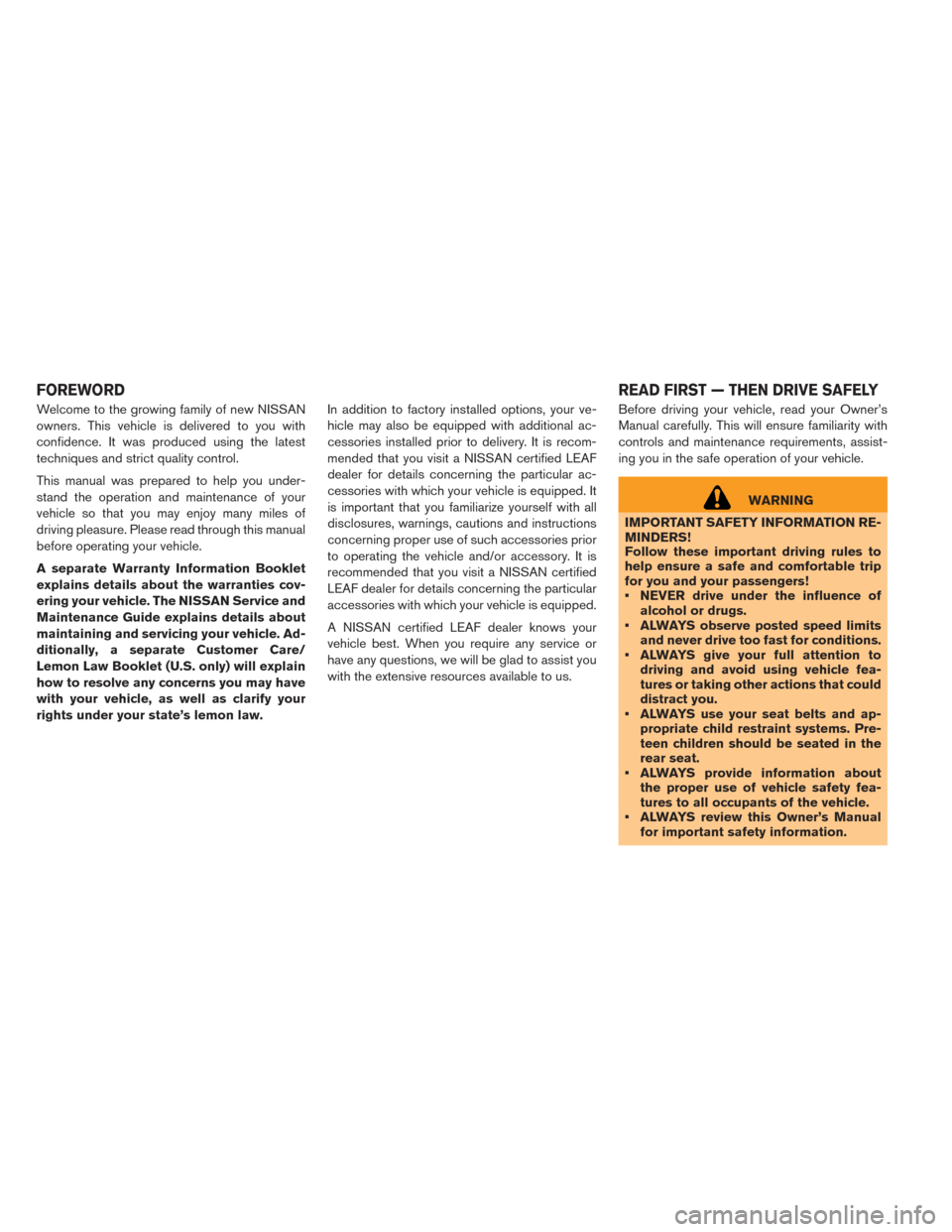
Welcome to the growing family of new NISSAN
owners. This vehicle is delivered to you with
confidence. It was produced using the latest
techniques and strict quality control.
This manual was prepared to help you under-
stand the operation and maintenance of your
vehicle so that you may enjoy many miles of
driving pleasure. Please read through this manual
before operating your vehicle.
A separate Warranty Information Booklet
explains details about the warranties cov-
ering your vehicle. The NISSAN Service and
Maintenance Guide explains details about
maintaining and servicing your vehicle. Ad-
ditionally, a separate Customer Care/
Lemon Law Booklet (U.S. only) will explain
how to resolve any concerns you may have
with your vehicle, as well as clarify your
rights under your state’s lemon law.In addition to factory installed options, your ve-
hicle may also be equipped with additional ac-
cessories installed prior to delivery. It is recom-
mended that you visit a NISSAN certified LEAF
dealer for details concerning the particular ac-
cessories with which your vehicle is equipped. It
is important that you familiarize yourself with all
disclosures, warnings, cautions and instructions
concerning proper use of such accessories prior
to operating the vehicle and/or accessory. It is
recommended that you visit a NISSAN certified
LEAF dealer for details concerning the particular
accessories with which your vehicle is equipped.
A NISSAN certified LEAF dealer knows your
vehicle best. When you require any service or
have any questions, we will be glad to assist you
with the extensive resources available to us.
Before driving your vehicle, read your Owner’s
Manual carefully. This will ensure familiarity with
controls and maintenance requirements, assist-
ing you in the safe operation of your vehicle.
WARNING
IMPORTANT SAFETY INFORMATION RE-
MINDERS!
Follow these important driving rules to
help ensure a safe and comfortable trip
for you and your passengers!
• NEVER drive under the influence of alcohol or drugs.
• ALWAYS observe posted speed limits and never drive too fast for conditions.
• ALWAYS give your full attention to driving and avoid using vehicle fea-
tures or taking other actions that could
distract you.
• ALWAYS use your seat belts and ap- propriate child restraint systems. Pre-
teen children should be seated in the
rear seat.
• ALWAYS provide information about the proper use of vehicle safety fea-
tures to all occupants of the vehicle.
• ALWAYS review this Owner’s Manual for important safety information.
FOREWORD READ FIRST — THEN DRIVE SAFELY
Page 8 of 424
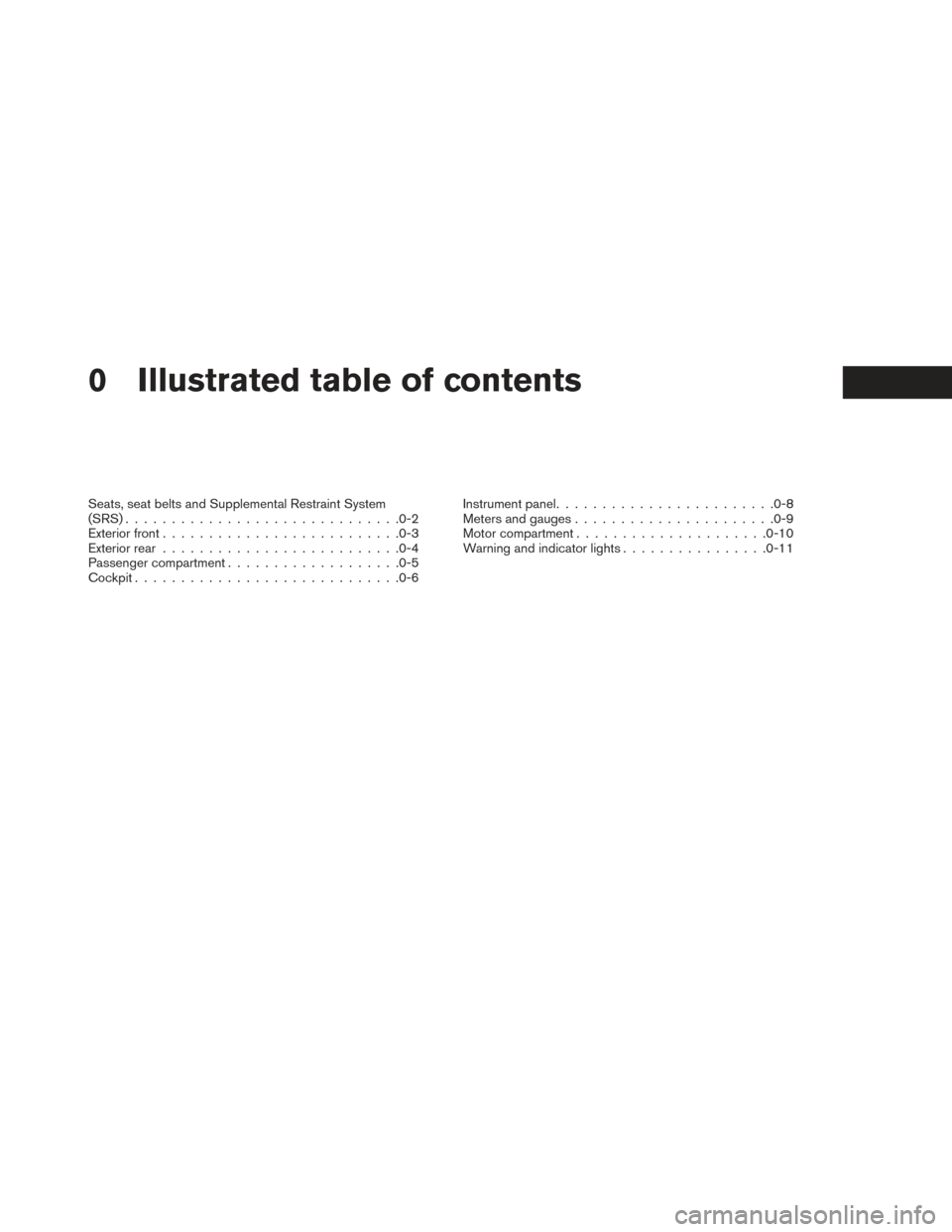
0 Illustrated table of contents
Seats, seat belts and Supplemental Restraint System
(SRS)............................. .0-2
Exterior front ......................... .0-3
Exterior rear ......................... .0-4
Passenger compartment .................. .0-5
Cockpit ............................ .0-6Instrument panel
....................... .0-8
Meters and gauges ..................... .0-9
Motor compartment .................... .0-10
Warning and indicator lights ................0-11
Page 9 of 424

1. Rear head restraints/headrests (P. 1-5)
2. Child restraint anchor points (for top tetherstrap child restraint) (P. 1-18)
3. Roof-mounted curtain side-impact and roll- over (if so equipped) air bags (P. 1-39)
4. Front seat belt with pretensioner(s) and shoulder height adjuster (P. 1-8, 1-39)
5. Front head restraints/headrests (P. 1-5)
6. Front seats (P. 1-2)
7. Supplemental front-impact air bags (P. 1-39)
8. Front passenger air bag status light (P. 1-39)
9. Occupant classification sensor (weight sen- sor) (P. 1-39)
10. Front seat-mounted side-impact supple- mental air bags (P. 1-39)
11. Rear seats (P. 1-2)
12. LATCH (Lower Anchors and Tethers for CHildren) system (P. 1-18)
SEATS, SEAT BELTS AND
SUPPLEMENTAL RESTRAINT
SYSTEM (SRS)
0-2Illustrated table of contents
Page 12 of 424
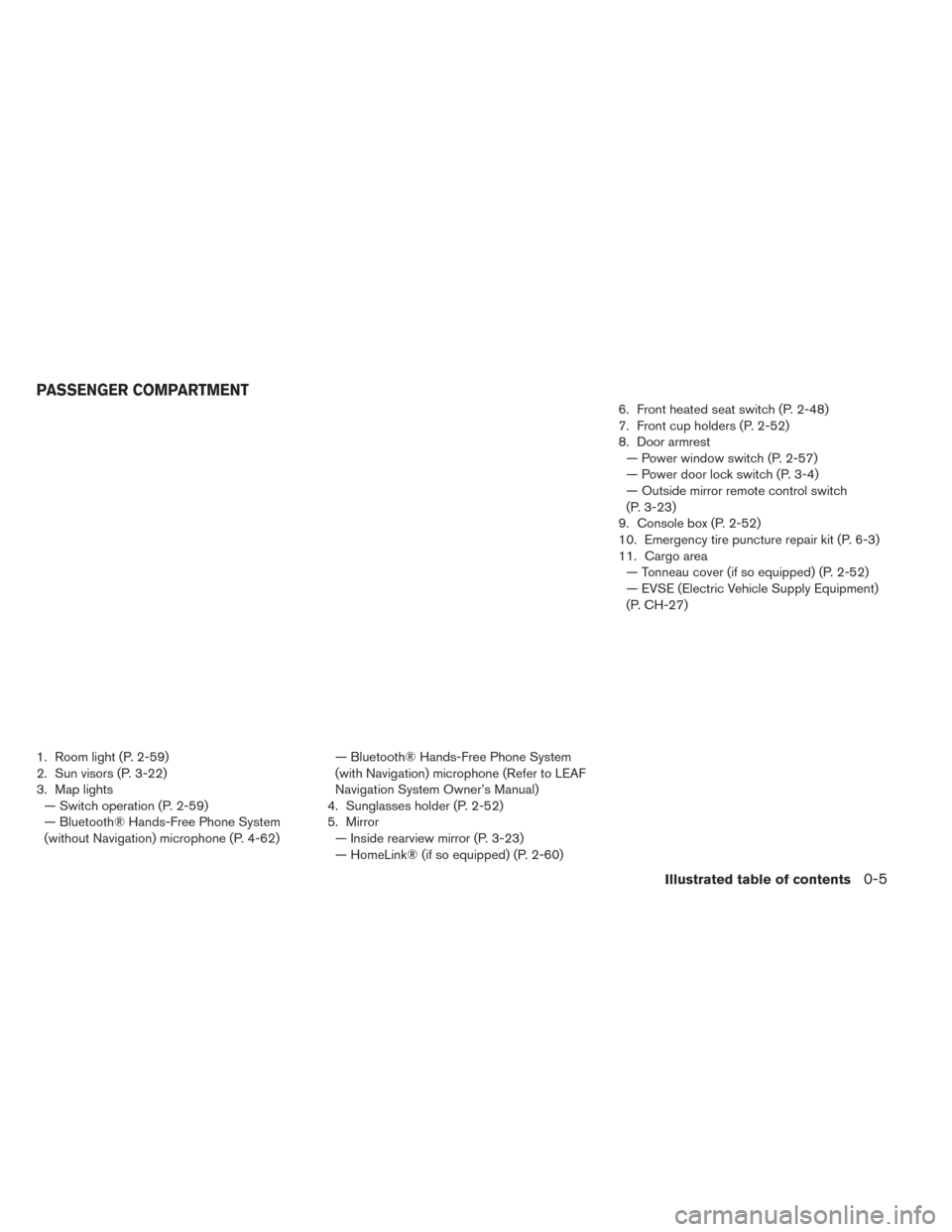
1. Room light (P. 2-59)
2. Sun visors (P. 3-22)
3. Map lights— Switch operation (P. 2-59)
— Bluetooth® Hands-Free Phone System
(without Navigation) microphone (P. 4-62) — Bluetooth® Hands-Free Phone System
(with Navigation) microphone (Refer to LEAF
Navigation System Owner’s Manual)
4. Sunglasses holder (P. 2-52)
5. Mirror — Inside rearview mirror (P. 3-23)
— HomeLink® (if so equipped) (P. 2-60) 6. Front heated seat switch (P. 2-48)
7. Front cup holders (P. 2-52)
8. Door armrest
— Power window switch (P. 2-57)
— Power door lock switch (P. 3-4)
— Outside mirror remote control switch
(P. 3-23)
9. Console box (P. 2-52)
10. Emergency tire puncture repair kit (P. 6-3)
11. Cargo area — Tonneau cover (if so equipped) (P. 2-52)
— EVSE (Electric Vehicle Supply Equipment)
(P. CH-27)
PASSENGER COMPARTMENT
Illustrated table of contents0-5
Page 84 of 424
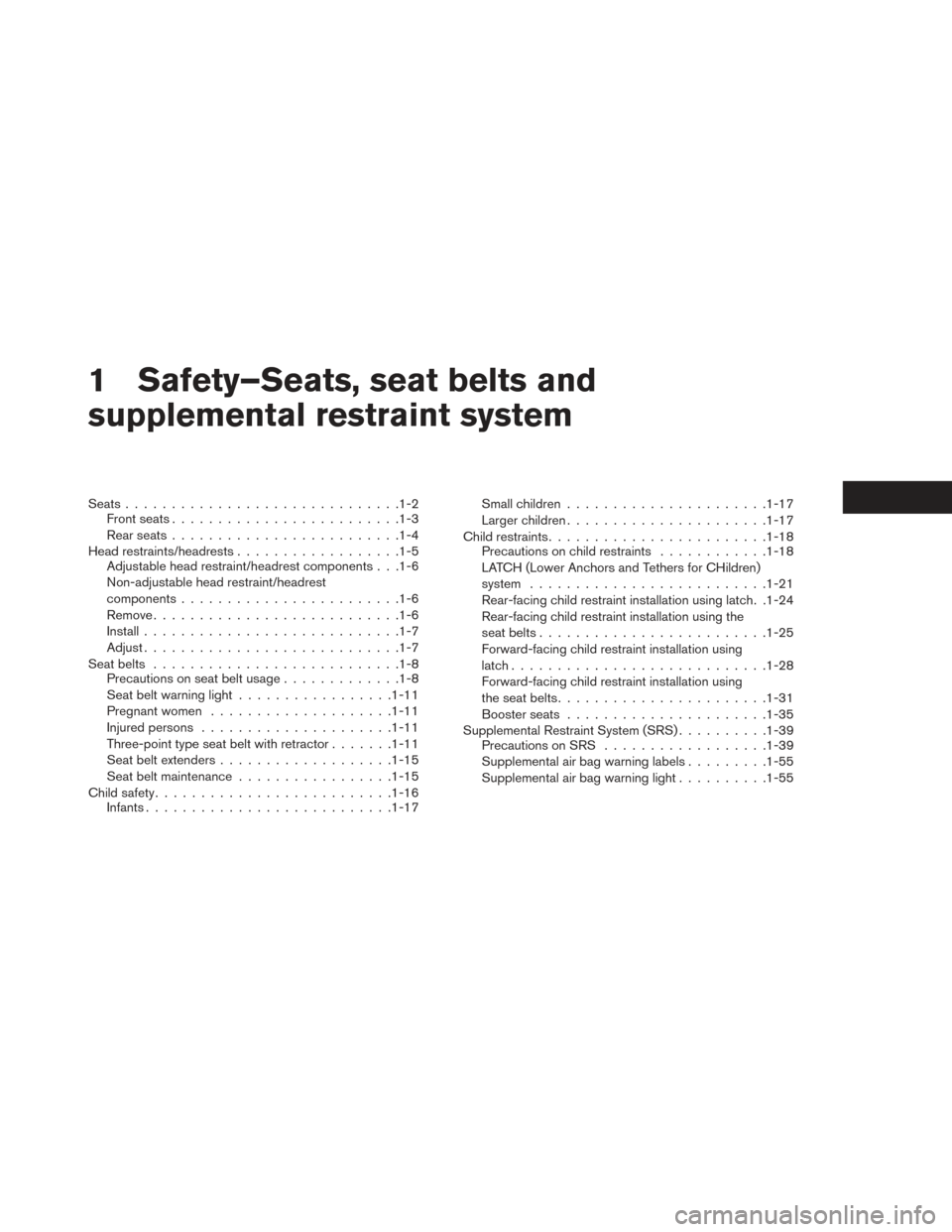
1 Safety–Seats, seat belts and
supplemental restraint system
Seats............................. .1-2
Front seats ........................ .1-3
Rear seats ........................ .1-4
Head restraints/headrests ................. .1-5
Adjustable head restraint/headrest components . . .1-6
Non-adjustable head restraint/headrest
components ....................... .1-6
Remove .......................... .1-6
Install ........................... .1-7
Adjust ........................... .1-7
Seat belts .......................... .1-8
Precautions on seat belt usage .............1-8
Seat belt warning light ................ .1-11
Pregnant women ................... .1-11
Injured persons .................... .1-11
Three-point type seat belt with retractor .......1-11
Seat belt extenders .................. .1-15
Seat belt maintenance ................ .1-15
Child safety ......................... .1-16
Infants .......................... .1-17Small children
..................... .1-17
Larger children ..................... .1-17
Child restraints ....................... .1-18
Precautions on child restraints ............1-18
LATCH (Lower Anchors and Tethers for CHildren)
system ......................... .1-21
Rear-facing child restraint installation using latch. .1-24
Rear-facing child restraint installation using the
seat belts ........................ .1-25
Forward-facing child restraint installation using
latch ........................... .1-28
Forward-facing child restraint installation using
the seat belts ...................... .1-31
Booster seats ..................... .1-35
Supplemental Restraint System (SRS) ..........1-39
Precautions on SRS ................. .1-39
Supplemental air bag warning labels .........1-55
Supplemental air bag warning light ..........1-55
Page 87 of 424

REAR SEATS
Folding
Before folding the rear seats:
• Secure the seat belts on the seat belt hookslocated on the side wall. For additional informa-
tion, refer to “Seat belt hook” in this section.
To fold down the seatback, pull the release knob.
To return the seatback to the seating position, lift
up each seatback and push it to the upright
position until it is latched.
WARNING
• Do not fold down the rear seats when occupants are in the rear seat area or
any objects are on the rear seats.
• Never allow anyone to ride in the cargo area or on the rear seats when they are
in the folded-down position. Use of
these areas by passengers without
proper restraints could result in seri-
ous injury or death in an accident or
sudden stop. • Properly secure all cargo with ropes or
straps to help prevent it from sliding or
shifting. Do not place cargo higher
than the seatbacks. In a sudden stop or
collision, unsecured cargo could cause
personal injury.
• When returning the seatbacks to the upright position, be certain they are
completely secured in the latched po-
sition. If they are not completely se-
cured, passengers may be injured in an
accident or sudden stop.
1-4Safety–Seats, seat belts and supplemental restraint system
Page 88 of 424
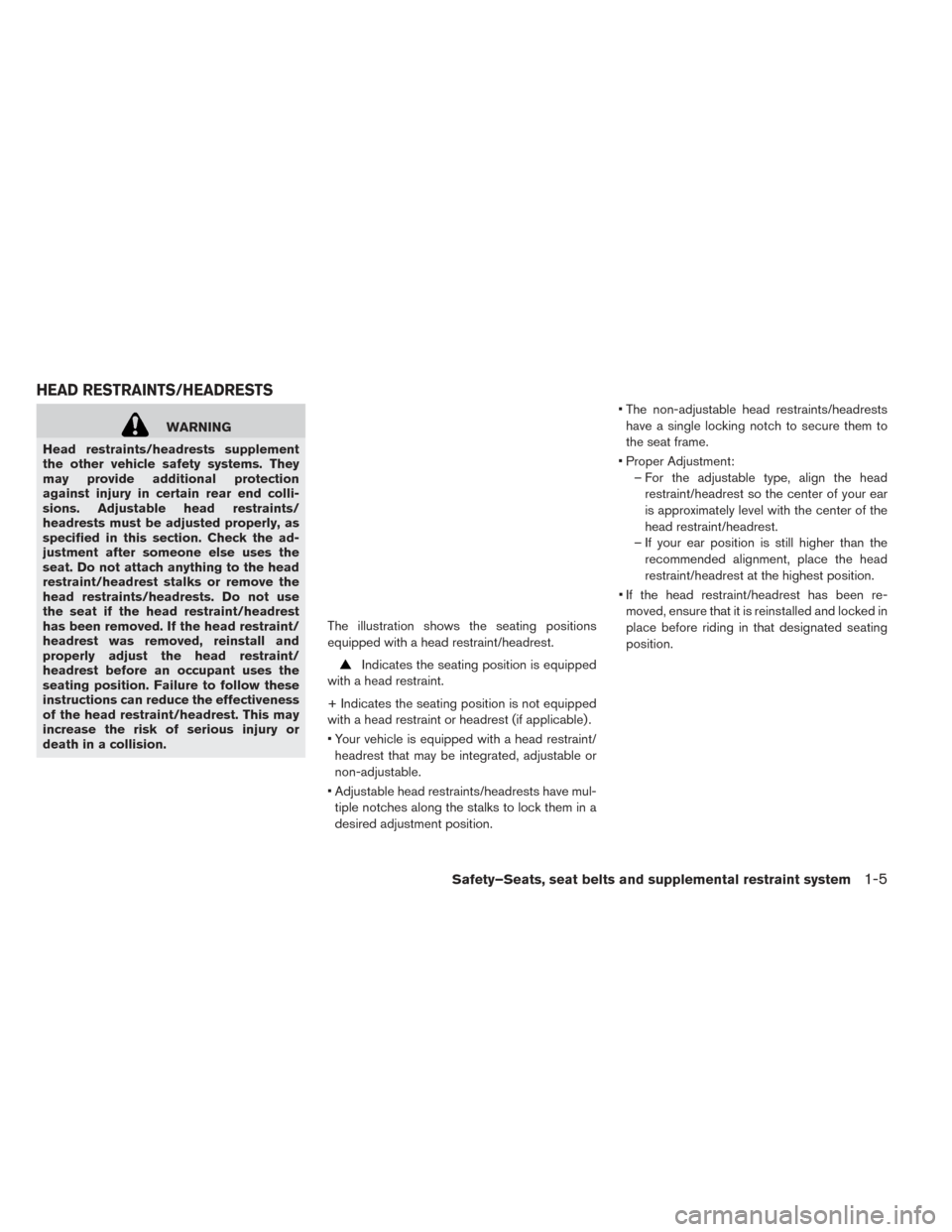
WARNING
Head restraints/headrests supplement
the other vehicle safety systems. They
may provide additional protection
against injury in certain rear end colli-
sions. Adjustable head restraints/
headrests must be adjusted properly, as
specified in this section. Check the ad-
justment after someone else uses the
seat. Do not attach anything to the head
restraint/headrest stalks or remove the
head restraints/headrests. Do not use
the seat if the head restraint/headrest
has been removed. If the head restraint/
headrest was removed, reinstall and
properly adjust the head restraint/
headrest before an occupant uses the
seating position. Failure to follow these
instructions can reduce the effectiveness
of the head restraint/headrest. This may
increase the risk of serious injury or
death in a collision. The illustration shows the seating positions
equipped with a head restraint/headrest.
Indicates the seating position is equipped
with a head restraint.
+ Indicates the seating position is not equipped
with a head restraint or headrest (if applicable) .
• Your vehicle is equipped with a head restraint/ headrest that may be integrated, adjustable or
non-adjustable.
• Adjustable head restraints/headrests have mul- tiple notches along the stalks to lock them in a
desired adjustment position. • The non-adjustable head restraints/headrests
have a single locking notch to secure them to
the seat frame.
• Proper Adjustment: – For the adjustable type, align the headrestraint/headrest so the center of your ear
is approximately level with the center of the
head restraint/headrest.
– If your ear position is still higher than the recommended alignment, place the head
restraint/headrest at the highest position.
• If the head restraint/headrest has been re- moved, ensure that it is reinstalled and locked in
place before riding in that designated seating
position.
HEAD RESTRAINTS/HEADRESTS
Safety–Seats, seat belts and supplemental restraint system1-5
Page 93 of 424

WARNING
• Every person who drives or rides in this vehicle should use a seat belt at all
times. Children should be in the rear
seats and in an appropriate restraint.
• The seat belt should be properly ad- justed to a snug fit. Failure to do so
may reduce the effectiveness of the
entire restraint system and increase
the chance or severity of injury in an
accident. Serious injury or death can
occur if the seat belt is not worn prop-
erly.
• Always route the shoulder belt over your shoulder and across your chest.
Never put the belt behind your back,
under your arm or across your neck.
The belt should be away from your face
and neck, but not falling off your
shoulder.
• Position the lap belt as low and snug as possible AROUND THE HIPS, NOT
THE WAIST. A lap belt worn too high
could increase the risk of internal inju-
ries in an accident.
• Be sure the seat belt tongue is se- curely fastened to the proper buckle. • Do not wear the seat belt inside out or
twisted. Doing so may reduce its effec-
tiveness.
• Do not allow more than one person to use the same seat belt.
• Never carry more people in the vehicle than there are seat belts.
• If the seat belt warning light glows continuously while the power switch is
turned ON with all doors closed and all
seat belts fastened, it may indicate a
malfunction in the system. Have the
system checked. It is recommended
that you visit a NISSAN certified LEAF
dealer for this service.
• No changes should be made to the seat belt system. For example, do not
modify the seat belt, add material, or
install devices that may change the
seat belt routing or tension. Doing so
may affect the operation of the seat
belt system. Modifying or tampering
with the seat belt system may result in
serious personal injury.
• Once seat belt pretensioner(s) have activated, they cannot be reused and
must be replaced together with the
retractor. It is recommended that you
visit a NISSAN certified LEAF dealer
for this service. • All seat belt assemblies, including re-
tractors and attaching hardware,
should be inspected after any colli-
sion. It is recommended that you visit a
NISSAN certified LEAF dealer for this
service. NISSAN recommends that all
seat belt assemblies in use during a
collision be replaced unless the colli-
sion was minor and the belts show no
damage and continue to operate prop-
erly. Seat belt assemblies not in use
during a collision should also be in-
spected and replaced if either damage
or improper operation is noted.
• All child restraints and attaching hard- ware should be inspected after any
collision. Always follow the restraint
manufacturer’s inspection instructions
and replacement recommendations.
The child restraints should be replaced
if they are damaged.
1-10Safety–Seats, seat belts and supplemental restraint system